Kerman is one of the must-see cities in southeastern Iran. Located in the heart of the desert, it houses several attractions and natural wonders. Dated back to the 4th millennium BCE, Kerman has several historical sites and landmarks in the region. Here you can find more about Kerman and its great attractions.
To name a few there are Bam citadel, Rayen castle, and Meymand village. Kerman carpets, jajims and kilims, and hand-woven textiles like pateh are some of the attractions you should not miss while visiting Kerman.
Read also: Some of Best Kerman Hotels in 2020

Historical attractions of Kerman
Ganj Ali Khan Complex

This unique architectural treasure is in the heart of Kerman.
The historical complex includes a bazaar, mosque, school, caravanserai, bathhouse, abnabar (cistern), mosque, and square.
The governor of Kerman Ganj Ali Khan (1596-1612) built this place during Shah Abbas I of the Safavid dynasty.
Mohammad Memar Yazdi was the architect of this 11000 square meter complex, which has four mosques in each corner.
Sartasari Bazaar
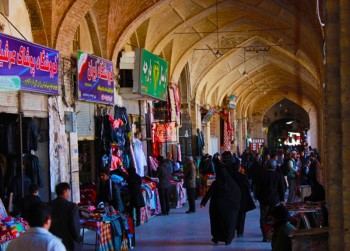
It is one of the oldest trading centers in Iran. Sartasari means end-to-end in Persian.
The 1200-meter long bazaar has several museums and a bathhouse.
In addition, the bazaar has four sections and 20 branches. Ganj Ali Khan Square, Ganj Ali Khan Mosque, the museum of coin and money, as well as the copper bazaar are some of its parts.
After visiting the place, have lunch or drink a cup of tea at the traditional teahouse in the heart of the bazaar.
Read also: Amazing Local Experiences in Iran
Attractions around Kerman
Traveling to Kerman, do not miss attractions near the city since there are traces of different civilizations and historical places there. Mahan Garden, Shah Nematollah Vali, and Bam citadel are some of these landmarks. Here you can find more details about these historical sites:
Arg-e Bam

As the largest adobe building in the world, Bam Citadel (Arg-e Bam) is dated back to the Achaemenid Empire (559–330 BCE). Although the Arg means citadel in the Persian language, Arg-e Bam is a fortress, which includes a citadel.
It is on the UNESCO World Heritage Site list as “Bam and its Cultural Landscape”. During its flourishing time, which was from the 7th to 11th century, Arg-e Bam was famous for its production of silk and cotton garments.
Arg-e Bam was used in different historical eras by the rulers. Some parts were added to the complex during the Safavid rule (1502-1722). However, during the Qajar Era (1789-1925) it gradually turned into a military center.
The Arg-e Bam has a residential zone, the stables, the army barracks, and the governor’s residence. It boasts 38 watchtowers and four entrance gates.
Shazdeh Garden

Located in 35 km southeast Kerman, it is on the ninth Iranian garden on UNESCO’s World Heritage List. It was built during the Qajar Era (1789-1925) in Mahan, near Kerman. Located in the heart of the desert, the water for this beautiful oasis is provided with the qanat system.
It is on a slope so gravity is used for the irrigation of the garden. The water enters the garden from above and there is a terraced pool in which, the water flows. There is a summerhouse on the top of the garden with an intriguing façade. Both the summerhouse and entrance gate of the garden are two-story buildings.
Shah Nematollah Vali Shrine

Do not miss visiting Shah Nematollah Vali Shrine who died in 1431. An Indian king built the shrine for a mystic poet. A blue cupola was added during the Abbasid era. During the Qajar era, two minarets are also constructed.
Also, you can find a prayer chamber with walls and a ceiling adorned with calligraphy. The Shah Nematollah Vali Shrine includes the Atabaki courtyard, Vakil-ol-Molki courtyard, Modir-ol-Molki portico, the shrine, Shah Abbasi portico, Mirdamad courtyard, and Hosseiniyeh courtyard.
Rayen Castle
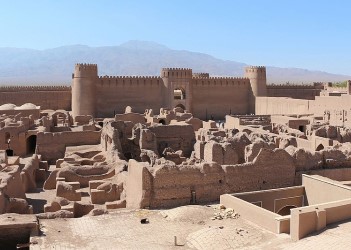
It is the second-largest adobe castle in the world after Bam citadel. Rayen castle is located in the skirts of Hezar Mountain near Kerman.
It is 100 kilometers southeast of Kerman city at an altitude of 2200 meters.
In fact, the castle dates back to the Sassanid era (224–651 CE).
It is on the trade route so it was a renowned place for merchants. 150 years ago, it housed about 5000 people.
In those times, the inhabitants build swords, guns, scissors, and locks, and other metal products. It has three parts for different social classes. They have two or three-story buildings.
Meymand rocky village
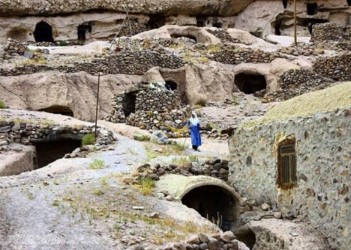
Meymand is another Kerman attraction. It is 38 km from Shahr-e Babak city, Kerman Province. This man-made village is in the heart of the mountain. According to some clays found in Meymand, the village is dated back to 2000 to 3000 years ago.
There are some castles, temples, and towers in the village. Nobody knows which tribe firstly established this village. It is composed of the hand-dug houses, which is Kicheh in the local langauge. The kicheh is a hand-dug structure and no brick or wood is in its construction.
The kicheh is five degrees warmer than the outside weather. There are 405 Kichehs in the village. It has one entrance and the spaces are divided with the curtain. The heating system is fire.
The dialect of people in the village has words that originated in some Sassanid era. There are still people living in Meymand so there is still an interaction between humans and nature. The dwellers earn life by farming and husbandry in the village.
Read also: Traditional Villages of Iran, An Exotic Experience
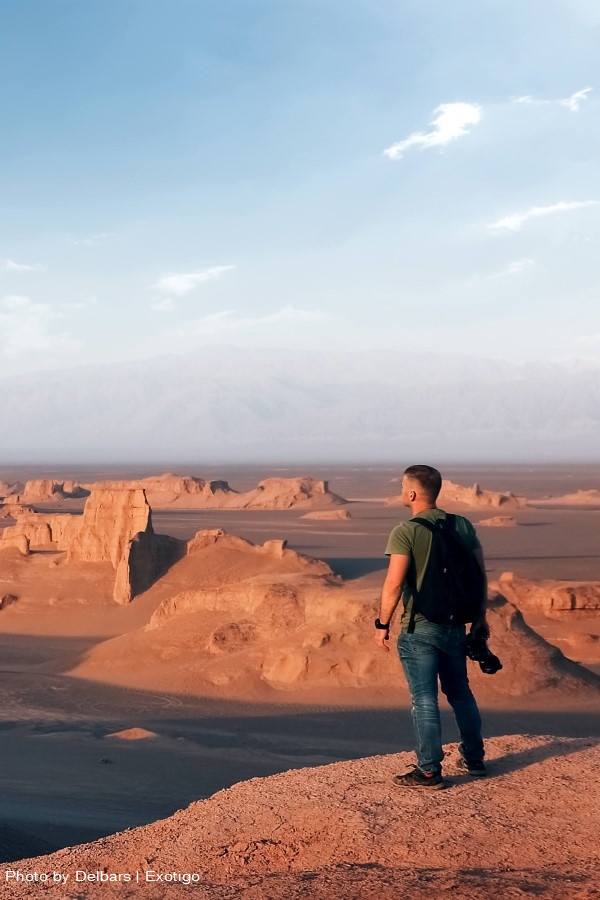
Another Kerman attraction: Shahdad Klout
In 40 km of northeastern Shahdad city in Kerman province, there is a legendary phenomenon Kalout. From a distance, you see a series of structures, which resemble a big city amid the desert. However, when you reach the place, you encounter a series of rocks that change their shape due to erosion. The best time to visit the kalouts is during sunrise and sunset when the sunshine plays a colorful game on these natural wonders.
Kalout is a part of Lut Desert and you can visit Rood-e Shoor (Salty River), the only river that flows in a desert all seasons during your visit to Shahdad.
A camp is located 20 km to Shahdad and provides you a facility to enjoy starry nights in the desert. You can also enjoy a safari, camel riding, and walking barefoot in the desert during your sojourn at the place. On Exotigo, you can book a tour to the Lut desert and enjoy its tranquility and wonder!
Kerman handicrafts
Pateh
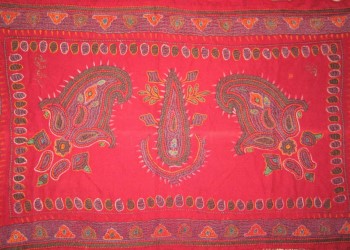
This fabulous needlework is from Kerman. Pateh is in fact a woolen shawl that is hand-dyed with embroidered patterns with wool threads.
The natural dye is from pomegranate, walnut, madder, and henna.
There is a toranj pattern in the center with paisley or botteh in each corner of pateh.
The borders also have flowers, leaves, and birds.
Kerman carpet
It boasts a variety of designs, natural dyes, and fibers. It has an asymmetrical knot on a cotton foundation, sometimes silk piles or silk foundations.
The most popular motif in Kerman carpet is Damask Rose. Gharb Qurani, Setooni, Ghabi, Kheshti, Saraam Atiyeh, and Jangali are other well-known motifs.
Read also: Tips You Wish to Know about Iran Culture
Cumin
Kerman is popular for its cumin (caraway). It was a major supplier of this spice in Iran for a long time ago. You can use it on rice, pastry, and other foods as well as some herbal medicines.
In fact, it grows in the mountains and there are three kinds of cumin in this region. If you travel to Kerman, do not forget to buy cumin and so enjoy its fragrance and taste in different cuisines.
Last but not least
Kerman is one of the must-see cities you should visit while traveling to Iran. It is a desert city where you can find different attractions. It is a great experience to visit citadels, spend the night under the starry nights of the desert, and mesmerize with fabulous patterns of Persian carpet.


